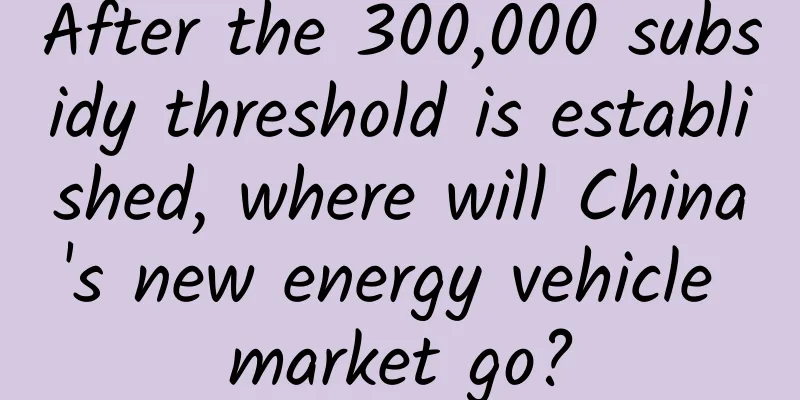After the 300,000 subsidy threshold is established, where will China's new energy vehicle market go?

|
After experiencing nine consecutive declines, new energy vehicle companies have finally got the life-saving pill of "new subsidy policy" - but this "new subsidy policy" obviously does not intend to save all car companies. On April 23, the Ministry of Finance, the Ministry of Industry and Information Technology and other four ministries jointly issued the "Notice on Improving the Financial Subsidy Policy for the Promotion and Application of New Energy Vehicles". In addition to the conventional extension of the financial subsidy policy for the promotion and application of new energy vehicles until the end of 2022, and the annual reduction of the subsidy standard by 10%, 20% and 30% respectively, the most eye-catching new policy is that "the pre-subsidy price of new energy passenger vehicles must be below 300,000 yuan (including 300,000 yuan)". Considering that the current domestic new energy market is showing a development trend of "one super and many strong", the new subsidy policy has put the same tight control on prices for all manufacturers focusing on volume, which may further intensify competition in the new energy market and trigger a second transformation in the new energy market. It’s all for the “children” The reason for setting the subsidy threshold of 300,000 yuan, according to the four ministries, is "to avoid a large amount of subsidy funds flowing into luxury consumption, taking into account factors such as the purchasing power level of Chinese consumers and industrial development." In fact, the 300,000 yuan subsidy threshold is ultimately to promote the prosperity of the new energy vehicle market. First, unlike fuel vehicles, which have balanced advantages and disadvantages, new energy vehicles have both obvious disadvantages and advantages. Therefore, in order to attract consumers, most new energy vehicle companies have targeted the price range below 300,000 yuan. For example, according to the sales list of new energy vehicles in the first quarter of 2020 compiled by the China Passenger Car Association, the average price of the top ten new energy vehicles is around 250,000 yuan. On the other hand, in terms of objective environment, new energy charging piles are already in the seven major areas of China's new infrastructure. The announcement shows that it is expected that by the end of 2020, 12,000 centralized charging and swapping stations and 4.8 million decentralized charging piles will be built. Five years later, more than 36,000 charging and swapping stations will be built, achieving a 1:1 ratio of cars to charging piles across the country. Considering that in the limited future, subsidies for new energy vehicles will inevitably shrink step by step, or even disappear, therefore, before the subsidies completely disappear, setting a threshold for manufacturers in popular price segments can make consumers' choices more focused. Based on this, it will help industry competition and stimulate product vitality. Interestingly, NIO is not within the "300,000 yuan subsidy threshold" limit, which makes many car companies doubt the fairness of the policy. In fact, from a policy perspective, the purpose of giving NIO a "special treatment" and setting a "300,000 yuan subsidy threshold" for the industry is actually the same. In order to ensure the user experience, NIO chose the "battery swap" service, but isolated development also caused an increase in operating costs. According to insiders, as of the end of 2019, NIO's investment in the NIO Power battery swap station project has reached 2 billion yuan, and NIO promised that the first owners of new ES8 and ES6 can enjoy lifetime free battery swap services - this part of the cost will inevitably be transferred to the selling price. Precisely because the high investment has such a huge impact on NIO's cash flow, in the second half of 2019, NIO also planned to split NIO Power and seek independent financing of about tens of billions of yuan. However, as of now, NIO Power's independence plan has not made any progress. On the other hand, the biggest drawback of new energy vehicles at present is the charging speed, which is often calculated in hours. However, Weilai's battery swap station can fully charge the car owners in just a few minutes, achieving the experience of a fuel car. The subsidy policy leaves a gap in this direction. On the one hand, it can ensure that NIO can attract consumers and survive. On the other hand, it also cleverly sets a benchmark for other new energy vehicle companies, and then it may promote the battery replacement model and reverse the long-standing disadvantages of new energy vehicles in terms of charging speed. In short, under the general trend of declining subsidies, the four ministries have made major adjustments to their subsidy policies. Their biggest motivation is to hope that subsidies can more effectively enable the hungry new energy vehicle companies to survive independently. There is no doubt that Tesla Model 3 will be reduced in price When talking about the new energy market, one topic that cannot be ignored is "Tesla". Coincidentally, the price of Model 3 is stuck at the edge of 300,000 yuan. I believe many people are also very curious about what Tesla will do in the face of the new policy. Here, we can make a bold prediction - the domestic price of Model 3 will definitely be adjusted to below 300,000 yuan. First, Tesla's Shanghai super factory has just been completed. According to Tesla, the localization rate of parts is only 30% at present. It is expected that the localization rate will reach 70% in July 2020, and 100% will be domestically produced by the end of the year. The higher the localization rate, the lower the hardware cost of Tesla. Interestingly, when the first batch of domestically produced Model 3 was launched on the market in early 2020, the price of the base version was reduced from 355,800 yuan to 323,800 yuan - and this is only the price with a localization rate of 30%. Secondly, according to data from CITIC Securities, after 100% domestic production, the comprehensive gross profit margin of Model 3 will reach more than 40%. In other words, if the gross profit margin is 40%, then Model 3 will have a price reduction space of about 130,000 yuan. From an industry perspective, data shows that in March 2020, Tesla sold 10,160 vehicles in China, accounting for 25% of the total market sales in a single month. Although this is data for all Tesla vehicles, the new domestically produced Model 3 long-range version released in early April received 20,000 orders within 24 hours, indicating that Model 3 is definitely the main sales force of Tesla vehicles. Now, the problem is very simple. By only reducing the price by about 6%, Tesla's car sales will be guaranteed, and its dominant position in the market will continue. Tesla, which is well aware of the laws of the Chinese market, has no reason not to do so. There are challenges, but overall it is good for the domestic new energy market In the industry situation of "one superpower and many strong companies", the new policy and Tesla's price cut will inevitably have a far-reaching impact on new car companies. Optimistic Xiaopeng believes that "it will have no impact on Xiaopeng Motors, but will be more beneficial", while pessimistic Li Xiang believes that "the policy will help Tesla to cripple domestic pure electric brands." In fact, if we consider the industry, we will find that both views are too extreme. First of all, we do not deny that with Tesla’s price cuts, the new energy market with a price range of 200,000 to 400,000 yuan will be attracted by Model 3, but all this is based on Tesla’s Shanghai factory. According to Tesla, the production capacity of Model 3 in the Shanghai factory is only 150,000 vehicles per year. Compared with the annual market demand of 1.2 million, and the draft of the "New Energy Vehicle Industry Development Plan (2021-2035)" released by the Ministry of Industry and Information Technology, the proportion of electric vehicles in my country's new car sales will reach 25% in 2025, and there is still a large piece of cake waiting for other car companies to tap. In addition, as Tesla gradually becomes localized, it will also stimulate the development of related supply chains in China. For example, Xinzhoubang, Dofluoro, Kodali and other power battery system suppliers have begun to cooperate with Tesla. On the other hand, this will promote the overall technological progress of the industry. In the long run, it will greatly benefit the development of new car companies. From the perspective of the entire industry, when facing Tesla, a tough foreign enemy, domestic new energy vehicle companies can also choose to develop in groups. For example, at the end of 2019, Xiaopeng Motors reached a cooperation with NIO to share each other's charging networks, attempting to form an alliance from an operational perspective and surpass Tesla at the service level. On the other hand, the new policy also leaves a gap for domestic emerging car companies to explore - the battery swap model. Although NIO is the only company that sticks to this model, on the one hand, the policy caters to it, and on the other hand, NIO also hopes to allow NIO Power to develop independently. Combined with the trend of domestic emerging car companies banding together, the future battery swap stations are likely to be to electric vehicles as gas stations are to fuel vehicles. In general, the new subsidy policy and Tesla's price cuts will indeed have a negative impact on some emerging car companies in the short term. However, considering the focus of the new subsidy policy and Tesla's limited production capacity, a larger number of car companies may seize this opportunity to actively cater to the new subsidy policy from the perspective of the market or products, so as to achieve a breakthrough in a higher dimension. As a winner of Toutiao's Qingyun Plan and Baijiahao's Bai+ Plan, the 2019 Baidu Digital Author of the Year, the Baijiahao's Most Popular Author in the Technology Field, the 2019 Sogou Technology and Culture Author, and the 2021 Baijiahao Quarterly Influential Creator, he has won many awards, including the 2013 Sohu Best Industry Media Person, the 2015 China New Media Entrepreneurship Competition Beijing Third Place, the 2015 Guangmang Experience Award, the 2015 China New Media Entrepreneurship Competition Finals Third Place, and the 2018 Baidu Dynamic Annual Powerful Celebrity. |
<<: The color TV market will be bright in 2018, and product strength is the key to success
>>: Cadillac Minister Feng Dan calls for anti-counterfeiting on Pinduoduo: refurbished cars, fakes
Recommend
Turning water into "milk" is a basic skill for chefs!
Can water be turned into "milk"? Of cou...
Analysis of KFC’s Private Domain Operations
Recently, the "Pikachuk" meal toy launc...
How does a QR code work? What do the black and white squares represent? | Digital Literacy
Audit expert: Jing Yuan, Intermediate Accountant ...
With a click-through rate of 6.44%, e-commerce brands leverage WeChat Moments ads to monetize efficiently!
In recent years, with the disappearance of traffi...
Major discovery! Could the plume fountains on Enceladus contain new evidence of extraterrestrial life?
A planetary science study published in Nature Ast...
Google Glass will stop taking orders and move from Google X to a new division
Google said it will stop taking orders for Google ...
How to save bidding promotion costs? How to adjust the bidding promotion cost if it is too high?
In the past, I was mainly responsible for optimiz...
A day's plan begins in the morning... Do you eat? Authoritative research: Skipping breakfast can damage your body!
With the development of society, in the busy work...
Why can pigeons return to their homes no matter where they fly?
Audit expert: Zhao Liangyu Associate Professor, S...
How to use Android's VectorDrawable class to draw vector images
Drawing vector graphics is not difficult - how to...
Why are many non-social apps so keen on social + content?
It is easy to create an APP, with a R&D team ...
Home appliance manufacturers must be wary of the frog effect: otherwise they will be stuck in the quagmire and unable to escape
The frog effect, which is caused by boiling a fro...
Product Operation: How to create a product from 0 to 1 and turn it into RMB?
The process of a product going from 0 to 1 and fi...
A wedding photography advertising case with a click-through rate of up to 5%!
In recent years, with the increasing number of bu...
Is it true that soft cotton is the magical "flower" that can change world history?
Magellan was determined to go around America in s...









